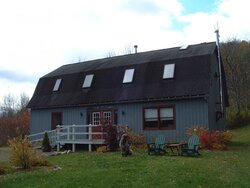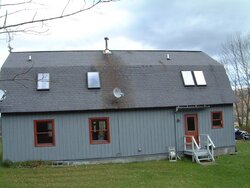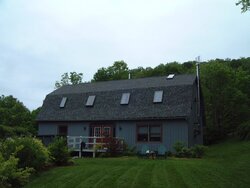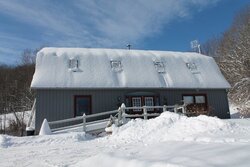Newly returning to wood burning. Been doing it daily now since October, and am having issues with my chimney becoming easily clogged. Apologize for the length of this, but trying to provide as much info ahead of time. Wondering about the root of my problem - is it placement of the house/chimneys? Or is it wood seasoning, the chimney(s), anything else?
This is a two story house. with a gambrel roof, 2 wood stoves (1 on each floor), and 2 SS chimneys. This house was formerly a ski/bike shop w/ an upstairs apartment. Place originally built about 1989, original owners lost it to the bank, it sat vacant for a year or two, we purchased it from the bank.
When we first had this house, we did limited burning in the downstairs wood stove - a Shenandoah. The upstairs is a Vermont Castings Intrepid. During those early years we had a big pile of wood delivered, and all of it too big to burn in the Intrepid.
I am in upstate NY. The house is located at the bottom of the eastern slope of a very high hill. This locale known for being windy, but the house is fairly protected by the hill.
The Shenendoah is on the gable end of the first floor, with a very high SS chimney running well past the top.
The Intrepid is in the center of the 2nd floor, with its SS chimney running straight up through the peak of the roof.
The house is very solid - quite airtight.
Due to various reasons - allergies, divorce, moving away for school, work - I stopped using the wood stoves. However, I had the chimneys checked/cleaned a few years ago. Then again at the end of this past summer. They were almost pristine. The chimney sweep had put chimney caps over the tops of both SS chimneys a few years ago. This year he also installed a damper in the flue of the Shenandoah. The stove had always burned hot and fast, and after reading suggestions on here, and from friends, thought this would help slow it down a little. Also last year, the bottom extension of the Shenandoah's chimney fell off. It ran below the elbow - I guess to allow for easy clean-out/and some accumulation. A local welder/family friend, put a cover back on the opening, but not a new extension.
Had about a face cord of wood cut last year at my neighbors - cut small enough for the Intrepid. Had to buy the rest of my wood from others. Several various individuals. Tried to buy only seasoned. The majority of what I purchased (about 4 cords) was seasoned, but had some odd pieces in it including a lot of small round logs. The wood mostly ash and maple. Bought another face cord of 8 month old ash. And my hunters on my land just cut up about 2 cord of downed trees (fallen 1 & 2 years ago) - oak, maple, ash, even some elm. The latter wood understandably, has been hardly used. (And this past month started logging my land, so now have about 15 cord newly cut/split in a huge pile in my back yard for next year!)
When I started this year, I tried out both stoves. The Shenandoah is not easy, the Intrepid impossible to start. The draft was terrible for the Intrepid. When we purchased this house, the roof - which covers more than half of the front of this house, was very stained below that chimney - almost 1/3 of the roof below it discolored. I had the roof replaced two years ago. Since I am downstairs 95% of the time, I've concentrated on the Shenandoah, and haven't bothered since to use the Intrepid. Have electric baseboard, so only burn when present. But returning to burning wood, a couple of new thermostats, and keeping them at 59 degrees has decreased my electric bill from $900 last December to $300 this December.
I understand all this wood burning has quite the learning curve. And yes, I wasn't burning hot enough. I start my fires with newspaper (not colored ads/inserts) and usually with a starter brick, with the smaller, older logs alongside. A few weeks ago I bought a moisture meter, and am now reading everything I put into that stove. The small round logs are not great at burning, even though they are seasoned. Nor does anything approaching 20% even if I throw it on a hot flame. But the Shenandoah can burn through in under an hour with decent wood. It keeps me busy!
About 3 weeks ago, I started getting some smoke coming more and more into the house when opening the door/starting the fire. Called the chimney sweep who is tied up with a large local commercial account. He advised doing a burn with a large amount of newspaper. Done. Worked ok for a day or two. Then got impossible. Called welder friend. He went out and bought a chimney brush and extensions and opened it up. It was a mess. With especially a large accumulation at about the roof edge He cleaned the length of it for me, and told me I should do it again in another 3 weeks. He also thought the chimney cap was not a great idea for this chimney. And noticed one or two tiny holes on the outside of the chimney close to the bottom. Said I may have to get it replaced in the near future, but it should be ok for now. :-( He also said the stainless steel chimneys had to have only very well seasoned wood??
Well, now 2 weeks later, it's already getting smokey when I open up that door again. I've hardly used the damper since, and kept the air input almost wide open the past week. Have tried to use only the best wood, but am running low on anything with almost no moisture.
Am about to head out after our new 10" of snow and attempt to do another cleaning.
I thought our chimney sweep was the cat's meow. But now not so sure about his advice. And wondering about the chimney caps.
And believe perhaps the location of this house isn't forgiving to keeping fires going easily. But having to clean the chimney every 2-3 weeks? Is that normal?!?
(PS At the beginning of the season, my hunter friends suggested I burn a chimney cleaning log about once a month, but then I read it doesn't do much past the elbow. True/false? Would it help?)
Thanks to all who stayed with me. Would love any advice. Also if down the road I should have the chimney replaced by local builders, or go to a stove specialist. Been really trying to be frugal. It's tough!
This is a two story house. with a gambrel roof, 2 wood stoves (1 on each floor), and 2 SS chimneys. This house was formerly a ski/bike shop w/ an upstairs apartment. Place originally built about 1989, original owners lost it to the bank, it sat vacant for a year or two, we purchased it from the bank.
When we first had this house, we did limited burning in the downstairs wood stove - a Shenandoah. The upstairs is a Vermont Castings Intrepid. During those early years we had a big pile of wood delivered, and all of it too big to burn in the Intrepid.
I am in upstate NY. The house is located at the bottom of the eastern slope of a very high hill. This locale known for being windy, but the house is fairly protected by the hill.
The Shenendoah is on the gable end of the first floor, with a very high SS chimney running well past the top.
The Intrepid is in the center of the 2nd floor, with its SS chimney running straight up through the peak of the roof.
The house is very solid - quite airtight.
Due to various reasons - allergies, divorce, moving away for school, work - I stopped using the wood stoves. However, I had the chimneys checked/cleaned a few years ago. Then again at the end of this past summer. They were almost pristine. The chimney sweep had put chimney caps over the tops of both SS chimneys a few years ago. This year he also installed a damper in the flue of the Shenandoah. The stove had always burned hot and fast, and after reading suggestions on here, and from friends, thought this would help slow it down a little. Also last year, the bottom extension of the Shenandoah's chimney fell off. It ran below the elbow - I guess to allow for easy clean-out/and some accumulation. A local welder/family friend, put a cover back on the opening, but not a new extension.
Had about a face cord of wood cut last year at my neighbors - cut small enough for the Intrepid. Had to buy the rest of my wood from others. Several various individuals. Tried to buy only seasoned. The majority of what I purchased (about 4 cords) was seasoned, but had some odd pieces in it including a lot of small round logs. The wood mostly ash and maple. Bought another face cord of 8 month old ash. And my hunters on my land just cut up about 2 cord of downed trees (fallen 1 & 2 years ago) - oak, maple, ash, even some elm. The latter wood understandably, has been hardly used. (And this past month started logging my land, so now have about 15 cord newly cut/split in a huge pile in my back yard for next year!)
When I started this year, I tried out both stoves. The Shenandoah is not easy, the Intrepid impossible to start. The draft was terrible for the Intrepid. When we purchased this house, the roof - which covers more than half of the front of this house, was very stained below that chimney - almost 1/3 of the roof below it discolored. I had the roof replaced two years ago. Since I am downstairs 95% of the time, I've concentrated on the Shenandoah, and haven't bothered since to use the Intrepid. Have electric baseboard, so only burn when present. But returning to burning wood, a couple of new thermostats, and keeping them at 59 degrees has decreased my electric bill from $900 last December to $300 this December.
I understand all this wood burning has quite the learning curve. And yes, I wasn't burning hot enough. I start my fires with newspaper (not colored ads/inserts) and usually with a starter brick, with the smaller, older logs alongside. A few weeks ago I bought a moisture meter, and am now reading everything I put into that stove. The small round logs are not great at burning, even though they are seasoned. Nor does anything approaching 20% even if I throw it on a hot flame. But the Shenandoah can burn through in under an hour with decent wood. It keeps me busy!
About 3 weeks ago, I started getting some smoke coming more and more into the house when opening the door/starting the fire. Called the chimney sweep who is tied up with a large local commercial account. He advised doing a burn with a large amount of newspaper. Done. Worked ok for a day or two. Then got impossible. Called welder friend. He went out and bought a chimney brush and extensions and opened it up. It was a mess. With especially a large accumulation at about the roof edge He cleaned the length of it for me, and told me I should do it again in another 3 weeks. He also thought the chimney cap was not a great idea for this chimney. And noticed one or two tiny holes on the outside of the chimney close to the bottom. Said I may have to get it replaced in the near future, but it should be ok for now. :-( He also said the stainless steel chimneys had to have only very well seasoned wood??
Well, now 2 weeks later, it's already getting smokey when I open up that door again. I've hardly used the damper since, and kept the air input almost wide open the past week. Have tried to use only the best wood, but am running low on anything with almost no moisture.
Am about to head out after our new 10" of snow and attempt to do another cleaning.
I thought our chimney sweep was the cat's meow. But now not so sure about his advice. And wondering about the chimney caps.
And believe perhaps the location of this house isn't forgiving to keeping fires going easily. But having to clean the chimney every 2-3 weeks? Is that normal?!?
(PS At the beginning of the season, my hunter friends suggested I burn a chimney cleaning log about once a month, but then I read it doesn't do much past the elbow. True/false? Would it help?)
Thanks to all who stayed with me. Would love any advice. Also if down the road I should have the chimney replaced by local builders, or go to a stove specialist. Been really trying to be frugal. It's tough!








 All good stuff mentioned here. So the "air tightness" could have a starving for air effect on all combustion devices????
All good stuff mentioned here. So the "air tightness" could have a starving for air effect on all combustion devices????